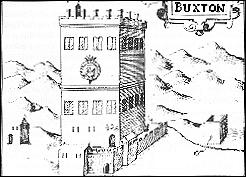Old Hall Hotel on:
[Wikipedia]
[Google]
[Amazon]
The Old Hall Hotel is a hotel in
 Since at least the
Since at least the  The tower was used at times between 1573 and 1584 to house
The tower was used at times between 1573 and 1584 to house
Buxton
Buxton is a spa town in the High Peak, Derbyshire, Borough of High Peak, Derbyshire, in the East Midlands region of England. It is England's highest market town, sited at some above sea level.Alston, Cumbria also claims this, but lacks a regu ...
, Derbyshire
Derbyshire ( ) is a ceremonial county in the East Midlands of England. It borders Greater Manchester, West Yorkshire, and South Yorkshire to the north, Nottinghamshire to the east, Leicestershire to the south-east, Staffordshire to the south a ...
, England, and is one of the oldest buildings in the town.
The current building dates from the Restoration period, built around and incorporating an earlier fortified tower.
According to the ''Derbyshire Archeological Journal'' (1994): "In the national context, the survival of a building which accommodated both Mary Queen of Scots and much of the Elizabethan nobility is of considerable note. Its importance in architectural terms is further enhanced as it is believed to be the earliest known British building of cross-axial form."
History of the building
Middle Ages
In the history of Europe, the Middle Ages or medieval period lasted approximately from the 5th to the late 15th centuries, similarly to the post-classical period of global history. It began with the fall of the Western Roman Empire and ...
, a hall has stood on this site by the warm spring for which Buxton water is known. The oldest part of the current building was once part of a four-storey fortified tower, built in 1572 by Bess of Hardwick and her fourth husband, George Talbot, 6th Earl of Shrewsbury.''A Brief History of the Old Hall Hotel'', 4-page leaflet published by the Old Hall Hotel and available from reception.
 The tower was used at times between 1573 and 1584 to house
The tower was used at times between 1573 and 1584 to house Mary, Queen of Scots
Mary, Queen of Scots (8 December 1542 – 8 February 1587), also known as Mary Stuart or Mary I of Scotland, was List of Scottish monarchs, Queen of Scotland from 14 December 1542 until her forced abdication in 1567.
The only surviving legit ...
, whilst she was in the custody of the Earl on the orders of Queen Elizabeth I
Elizabeth I (7 September 153324 March 1603) was Queen of England and Ireland from 17 November 1558 until her death in 1603. She was the last and longest reigning monarch of the House of Tudor. Her eventful reign, and its effect on history ...
. According to Doctor John Jones of Derby, author of ''Buxtone's Bathes Benefyte'' (1572), the tower was a lodging, purpose-built for those taking the waters. Visitors to Shrewsbury's "goodly house" enjoyed a game of table bowls known as ''trou madame''. Women guests had their own bench for the game, the men could play in a gallery. In fine weather they could play bowls outside in an alley or practice archery and other exercises.
Her last visit to Buxton was in the summer of 1584. It is claimed that it was Mary who inscribed the following couplet to Buxton on a window pane:
Buxton, whose warm waters have made thy name famous, perchance I shall visit thee no more – Farewell.The inscription can still be seen in the window of room 26. The Hall was rebuilt by one of Bess of Hardwick's descendants, the first of five Dukes of Devonshire, in 1670.
Use as a hotel
By 1727, the Old Hall had become a hotel, the only one in Buxton, where the writerDaniel Defoe
Daniel Defoe (; born Daniel Foe; 1660 – 24 April 1731) was an English writer, merchant and spy. He is most famous for his novel ''Robinson Crusoe'', published in 1719, which is claimed to be second only to the Bible in its number of translati ...
stayed on his tour of Great Britain. Of the Hall he wrote: "The Duke of Devonshire ... has built a large handsome house at the bath, where there is convenient lodging, and very good provisions, and an ordinary well served for one shilling per head; but it is but one."
By the time that the nearby Georgian Crescent
A crescent shape (, ) is a symbol or emblem used to represent the lunar phase (as it appears in the northern hemisphere) in the first quarter (the "sickle moon"), or by extension a symbol representing the Moon itself.
In Hindu iconography, Hind ...
was built (1780–86), Buxton had become an established spa town; and the Old Hall had become a fashionable hotel for the Georgian aristocracy taking the waters. In 1791 one James Cumming (father of the noted chemist James Cumming) leased what was then called Buxton Hall Hotel from William Cavendish, 5th Duke of Devonshire in 1791. He was considered socially more than a mere hotelier, and the hotel's clientele included bishops and visiting aristocracy. The Old Hall has served as a hotel ever since.
See also
* Grade II* listed buildings in High Peak * Listed buildings in BuxtonReferences
{{Use dmy dates, date=April 2020 Hotels in Derbyshire Buildings and structures in Buxton Country houses in Derbyshire Grade II* listed buildings in Derbyshire Country house hotels